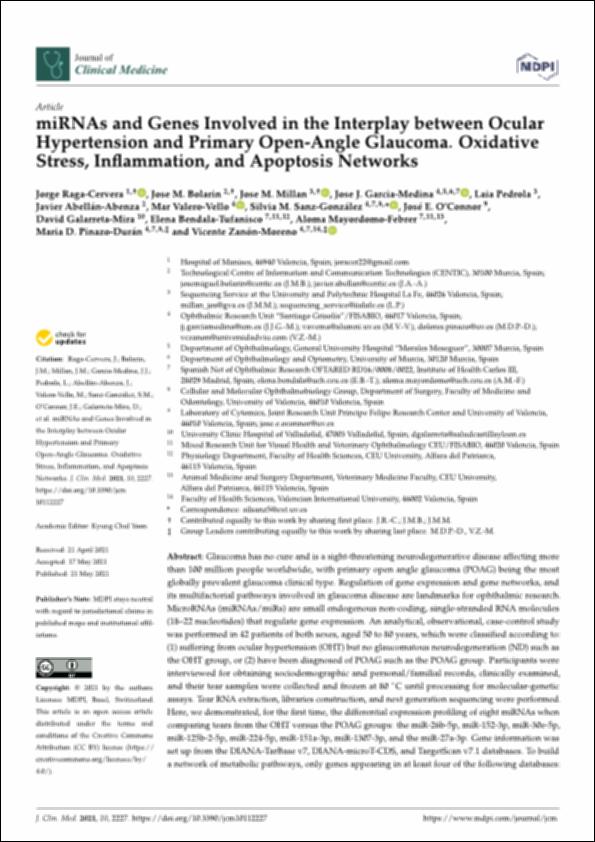Please use this identifier to cite or link to this item:
http://hdl.handle.net/10637/13039miRNAs and genes involved in the interplay between ocular hypertension and primary open-angle glaucoma : oxidative stress, inflammation, and apoptosis networks
| Title: | miRNAs and genes involved in the interplay between ocular hypertension and primary open-angle glaucoma : oxidative stress, inflammation, and apoptosis networks |
| Authors : | Raga Cervera, Jorge Bolarín Guillén, José Miguel Millán Salvador, José María García Medina, José Javier Pedrola Vidal, Laia Abellán Abenza, Javier Bendala Tufanisco, Elena Mayordomo Febrer, Aloma Tadea |
| Keywords: | Apoptosis.; Estrés oxidativo.; Oxidative stress.; Presión intraocular.; Biochemical markers.; Glaucoma.; Intraocular pressure.; Marcadores bioquímicos. |
| Publisher: | MDPI |
| Citation: | Raga-Cervera, J., Bolarin, J.M., Millan, J.M., Garcia-Medina, J.J., Pedrola, L., Abellán-Abenza, J. et al. (2021). miRNAs and genes involved in the interplay between ocular hypertension and primary open-angle glaucoma: oxidative stress, inflammation, and apoptosis networks. Journal of Clinical Medicine, vol. 10, art. 2227 (21 may.). DOI: https://doi.org/10.3390/jcm10112227 |
| Abstract: | Glaucoma has no cure and is a sight-threatening neurodegenerative disease affecting more than 100 million people worldwide, with primary open angle glaucoma (POAG) being the most globally prevalent glaucoma clinical type. Regulation of gene expression and gene networks, and its multifactorial pathways involved in glaucoma disease are landmarks for ophthalmic research. MicroRNAs (miRNAs/miRs) are small endogenous non-coding, single-stranded RNA molecules (18–22 nucleotides) that regulate gene expression. An analytical, observational, case-control study was performed in 42 patients of both sexes, aged 50 to 80 years, which were classified according to: (1) suffering from ocular hypertension (OHT) but no glaucomatous neurodegeneration (ND) such as the OHT group, or (2) have been diagnosed of POAG such as the POAG group. Participants were interviewed for obtaining sociodemographic and personal/familial records, clinically examined, and their tear samples were collected and frozen at 80 C until processing for molecular-genetic assays. Tear RNA extraction, libraries construction, and next generation sequencing were performed. Here, we demonstrated, for the first time, the differential expression profiling of eight miRNAs when comparing tears from the OHT versus the POAG groups: the miR-26b-5p, miR-152-3p, miR-30e-5p, miR-125b-2-5p, miR-224-5p, miR-151a-3p, miR-1307-3p, and the miR-27a-3p. Gene information was set up from the DIANA-TarBase v7, DIANA-microT-CDS, and TargetScan v7.1 databases. To build a network of metabolic pathways, only genes appearing in at least four of the following databases: DisGeNet, GeneDistiller, MalaCards, OMIM PCAN, UniProt, and GO were considered. We propose miRNAs and their target genes/signaling pathways as candidates for a better understanding of the molecular-genetic bases of glaucoma and, in this way, to gain knowledge to achieve optimal diagnosis strategies for properly identifying HTO at higher risk of glaucoma ND. Further research is needed to validate these miRNAs to discern the potential role as biomarkers involved in oxidative stress, immune response, and apoptosis for the diagnosis and/or prognosis of OHT and the prevention of glaucoma ND. |
| Description: | Este artículo se encuentra disponible en la siguiente URL: https://www.mdpi.com/2077-0383/10/11/2227 En esta investigación también participan: Mar Valero Vello, Silvia M. Sanz González, José E. O'Connor, David Galarreta Mira, María D. Pinazo-Durán y Vicente Zanón Moreno. Este artículo pertenece al número especial "Recent Clinical Research on Glaucoma". |
| URI: | http://hdl.handle.net/10637/13039 |
| Rights : | http://creativecommons.org/licenses/by/4.0/deed.es |
| ISSN: | 2077-0383 (Electrónico) |
| Issue Date: | 21-May-2021 |
| Center : | Universidad Cardenal Herrera-CEU |
| Appears in Collections: | Dpto. Medicina y Cirugía Animal |
Items in DSpace are protected by copyright, with all rights reserved, unless otherwise indicated.


